
Topics
Guests
- Joel Kupfermanexecutive director of the New York Environmental Law and Justice Project. He was co-counsel for a group of residents and workers suing the EPA and ex-EPA Head Christine Todd Whitman.
- Anthony DePalmaformer New York Times correspondent who covered the 9/11 health issues, author of City of Dust: Illness, Arrogance, and 9/11.
An often-forgotten group victims in the September 11th narrative are the many rescue workers who fell sick after being exposed to contaminants at Ground Zero. According to a new article by ProPublica, recently uncovered documents reveal that federal officials in Washington and New York went further than was previously known to downplay concerns about health risks, and misrepresented or concealed information that might have protected thousands of people from the contaminated air at Ground Zero. Meanwhile, a new study has provided potentially groundbreaking evidence of a link between exposure to toxic debris at Ground Zero and the development of cancer. The medical journal, The Lancet, reports male firefighters exposed to dust and smoke at Ground Zero have a 19 higher percent risk of developing cancer than colleagues who were not exposed. The finding comes just one month after the National Institute for Occupational Safety and Health ruled there’s insufficient evidence to draw a link between the smoldering ruins of the World Trade Center after 9/11 and cancer. Firefighters and rescue workers have been unable to receive payments for cancer treatments because cancer is not covered under legislation providing care for 9/11 responders. We speak with Anthony DePalma, author of “City of Dust: Illness, Arrogance, and 9/11.” His latest article for ProPublica is called “New Docs Detail How Feds Downplayed Ground Zero Health Risks.” We’re also joined by Joel Kupferman, executive director of the New York Environmental Law and Justice Project. He was co-counsel for a group of residents and workers suing the EPA and ex-EPA Head Christine Todd Whitman. [includes rush transcript]
Transcript
JUAN GONZALEZ: We turn now to a group of victims that are often forgotten in the September 11th narrative: the many rescue workers who have fallen sick after being exposed to contaminants at Ground Zero. According to a new article by ProPublica, recently uncovered documents show that federal officials in Washington and New York went further than was previously known to downplay concerns about health risks. The article says those officials misrepresented or concealed information that might have protected thousands of people from the contaminated air at Ground Zero.
AMY GOODMAN: Meanwhile, a new study has provided potentially groundbreaking evidence of a link between exposure to toxic debris at Ground Zero and the development of cancer. The medical journal, The Lancet, reports male firefighters exposed to dust and smoke at Ground Zero have a 19 higher percent risk of developing cancer than colleagues who were not exposed. The finding comes just a month after the National Institute for Occupational Safety and Health issued that there is insufficient evidence to draw a link between the smoldering ruins of the World Trade Center after 9/11 and cancer. Firefighters and rescue workers have been unable to receive payments for cancer treatments because cancer is not covered under the legislation providing care for 9/11 responders.
In 2009, we spoke with Dr. Jacqueline Moline about the prevalence of cancer among Ground Zero workers. She was the director of the World Trade Center Medical Monitoring and Treatment Program at Mount Sinai School of Medicine at the time.
DR. JACQUELINE MOLINE: We saw a group of younger workers at the site who developed a cancer of the immune system and multiple myeloma. And while it’s premature to be able to say that rates, in general, are elevated as a result of the exposures, what we’re seeing is an unusual age distribution. It’s a cancer usually we see in 60- or 70-year-old folks. And we saw four people under the age of 45. We’ve also seen other folks who are in the younger age category, much higher than we would expect. We would expect one person with cancer under 45 in the size of the population that we’re following.
AMY GOODMAN: That was Dr. Jacqueline Moline, who was the director of the World Trade Center Medical Monitoring and Treatment Program at Mount Sinai School of Medicine.
Well, for more on 9/11-related health ailments, we’re joined by two guests here in New York. Anthony DePalma, former New York Times correspondent who covered 9/11 health issues, he’s also the author of City of Dust: Illness, Arrogance, and 9/11. His latest article for ProPublica is called “New Docs Detail How Feds Downplayed Ground Zero Health Risks.”
And we’re joined by Joel Kupferman, executive director of the New York Environmental Law and Justice Project, was co-counsel for a group of residents and workers suing the EPA and ex-EPA head Christine Todd Whitman.
And, of course, Juan. Now, of course, Juan is co-host on Democracy Now!, but he is also the author of Fallout: The Environmental Consequences of the World Trade Center Collapse. Amazing, Juan, your book came out just really months after the September 11th attacks, exposing particularly Christine Todd Whitman and what she had to say at the time.
JUAN GONZALEZ: Yes, that was in May of 2002. And I’d like to begin, first, with Anthony. The latest article that you’ve come up with in ProPublica, could you talk about that and the new revelations?
ANTHONY DePALMA: Yeah, sure. First of all, I want to make clear that these documents that we were able to review, because they were gotten through Freedom of Information requests by the New York Committee on Occupational Safety and Health, build on a lot of the reporting that you did. Now let’s get that straight. I mean, you were there at the beginning, and you sort of pointed at these issues at a time when the government was saying, “Well, maybe we don’t need to worry about it.” And so, you raised the flag. And Joel, also, getting some documents early on.
What these—these go beyond what we already knew. We knew that there had been a certain amount of manipulation on the part of the White House, but what this shows is that they really were doing it from the very beginning. And there was a concern—you know, it’s interesting that we’re talking now, right after you did that piece on the World Trade Center building and how costly it is and how much it’s supposed to be a symbol of something, that’s sort of gone—the whole thing has gone awry.
In many ways, what was happening back then is that they were really worried about symbolism, a symbolism of people getting back to work, no matter what, and they didn’t level with people. And that’s the most disturbing thing. There were clear warnings, specifically on Water Street, which for those people in this area know is not far from Wall Street, that show that the levels of contaminants in the air were too high for people to go back. That was removed, which was bad enough, and then replaced with a recommendation that people go back to work. They were urged to go back, even though the early samples were showing that there were high levels of contaminants.
JUAN GONZALEZ: And you point out also that in many cases they were telling people it was safe before they had even finished conducting initial tests.
ANTHONY DePALMA: In one email exchange that happens on the 13th, so it’s just a day and a half later, the people in Washington at the White House Council on Environmental Quality are telling the people up here, “Hey, Christine Whitman is coming up. She’s going to talk to reporters, because all the results so far have been so positive.” Well, all the results so far showed almost nothing, because there were almost no results. And yet, they were committed to this message of reassurance, despite the facts. And that’s not the way it should happen.
AMY GOODMAN: And the effects of this, Joel Kupferman? Talk about the people you have represented down at Ground Zero.
JOEL KUPFERMAN: I’ve represented the firefighters. I’ve represented the residents in Lower Manhattan, the students at Stuyvesant High School, office workers. And they are definitely suffering from 9/11 exposure. What was interesting was that we knew that these substances were cancerous. We knew, with certainty, that there was lead, there was dust, silicone, everything else that was there. And yet, we—I think we’re claiming a little too much on the federal government. The city had a big stake there also. The city knew what was there, and part of the problem is that they did not allow those workers to protect themselves.
JUAN GONZALEZ: We were at a panel yesterday that dealt with 9/11, and afterwards, you told me something that really stuck in my mind. You said that, given the climate and the change in government procedures since 9/11, it would probably be much more difficult, if another disaster occurred, for you to get the Freedom of Information, FOIA, responses that you got back in 2001 so quickly, and that it would be a lot more difficult now to get the kind of information you were able to unearth back then.
JOEL KUPFERMAN: That’s totally true. As a matter of fact, we went down to the Gulf to see what was going down there, and we found that workers weren’t even allowed to take the samples of the soil that they had at the places. We also found that at community meetings, that people weren’t even allowed to record or take pictures of the ongoing talks.
But what we want to say is that what’s interesting now is that it’s the union fire department studies, Prezant, that shows that there’s cancer—that there’s cancer there. What we objected to was that when the city went to hire all those cleanup workers, after we—the city and the Feds said that there was a problem down there, we asked that there be baseline tests on those workers to show what levels they were at, and then, if they got sick, we could show how they got sick and to get immediate benefits. But the city refused to put those baseline tests in, and they made those people go through many, many hurdles to get any type of benefits.
AMY GOODMAN: Over the years, we’ve talked to many workers at Ground Zero, what’s called “the Pile.” In 2009, we spoke to Joe Picurro, a former freelance iron worker, worked at Ground Zero after 9/11, suffering from terminal lung disease, 42 years old. This is how he described his condition.
JOE PICURRO: Well, right now I’m hooked up to my oxygen machine. You know, my lungs are—I went to the doctor yesterday, and it was—we didn’t get good news. Basically, the doctor said, you know, if he could get me another year or two, you know, he would—you know, he’d be surprised. And so, I’m on 37 medications—well, actually 39. He put me on two more, you know, when I went to see him yesterday.
And, you know, most of my problems come from my lungs, but my whole body is racked with pain, all my joints. It’s just like a laundry list of problems. If it’s not one thing, it’s another, you know? Breathing, like I said, is the hardest. Like I said, I’m hooked up to oxygen now. My lungs have concrete and glass and human bone fragments in them. And, you know, so what happens is your lungs are the only organ that rejuvenate themselves, and mine, instead of growing viable lung tissue, they’re growing—it’s growing scar tissue. So it’s making my lungs get bigger and bigger. And when I take a deep breath, my lungs actually rub against my ribs, and it hurts.
AMY GOODMAN: Joe died soon after we spoke. Joe Picurro died on October 15, 2010. And then there’s Yolanda Hernandez. We spoke to her in 2007, longtime resident of the Lower East Side who’s suffered serious health effects from the toxic dust at Ground Zero. I asked her to describe where she was on September 11th and what happened afterwards.
YOLANDA HERNANDEZ: That day, I be in my house. And I see, you know, the coming a lot of this dust in my house, a lot of dust. So I say, what happening? I don’t know what happening. So I put my head, you know, out the window. I see the Twin, you know, go down. So I say, “Oh, my god, what happened?” So I told my daughter, “What’s going on?” But then I say, “What happened?” I say anything—you know, coming down dust, and I be coughing. So I tried to clean it, to clean it.
But two months later, I feel like a pain in my chest. So I go to the hospital to see what’s going on. And the doctor said that I have a problem in the respiratory. I hear about the program in Bellevue. They have a—
AMY GOODMAN: Bellevue Hospital in New York.
YOLANDA HERNANDEZ: Bellevue Hospital, Red Cross. So I go over there to get—they told me they do an examination complete. So they do an examination complete, and they found I have an inflammation in my lung. I never have this in my life. And now I’m taking medication twice a day. I said to the doctor, “Am I going to have the inflammation all my life?” He said, “Yeah, because, you know, your lung is—you know, they’re no good.” And that’s because of the dust. And that’s coming from that. But my point is, why they lie? Why Christine would lie that the air is clean, when that is not true?
AMY GOODMAN: That was Yolanda Hernandez, longtime resident of the Lower East Side, who suffered serious health effects. Joel Kupferman, is she in the zone that—
JOEL KUPFERMAN: She’s out of the zone. The zone was arbitrarily drawn at Canal Street. People that could receive treatment now are basically covered below Canal. If they’re above Canal, they have to go through major hurdles to prove that they’re hurt, which is—
AMY GOODMAN: But then they expanded the zone?
JOEL KUPFERMAN: The expanded it up to Canal. First they said Reade Street. And the problem is that it left out half of Chinatown, the people north of that site, and also the people in Brooklyn and elsewhere.
JUAN GONZALEZ: And by the “zone,” you mean to be covered by what?
JOEL KUPFERMAN: The Zagroda Compensation Act.
AMY GOODMAN: The Zagroda Compensation Act that doesn’t include cancer.
JOEL KUPFERMAN: That doesn’t include cancer, yes. So the problem is that these people are left out. And not only that, that it also just shows that, from the beginning, they didn’t really want to know who was hurt. They drew this arbitrary line, and it was CDC that refused to test people above that line. It was the EPA that didn’t test the apartments above that line. So, problem is, is that we knew for certainty that the chemicals would cause those dangers in the beginning, and they also say they didn’t know, and now they’re telling us they don’t know how many people are going to be hurt from the cancer. But we do know that there was a whole host of chemicals out there that do cause cancer.
JUAN GONZALEZ: I’d like to ask Anthony DePalma, because, clearly, cancer is the kind of illness that takes decades to develop, and few people expected there would be even a high—any kind of an increase among the workers at Ground Zero, so—10 years down the line. But now, the fire department’s new report comes out and says a 17 percent higher rate than expected, compared to workers who were not at the site, firefighters and rescue people who were not at the site. Your sense of the settled science on this? Obviously, it’s a big controversy still.
ANTHONY DePALMA: Big, absolutely. If you look at that Lancet article and the study that Dr. Prezant did, it showed that increase for all cancers. So they—it’s not the way they normally do a study like that. So they put all the cancers together. Interestingly, what they found was that there was no increase in lung cancer. It was actually less than might have been anticipated. That’s probably because firefighters are pretty healthy people, and they wouldn’t have—and also younger. What that means, though, is not that there is no lung cancer. They actually—the scientists wouldn’t have expected to see an increase in lung cancer, because the incubation period between exposure to the asbestos, which would have been in 2001, and the appearance of the disease might be three decades.
So, while he came back with the figure of 19 percent increase and didn’t show any increase in lung cancer, he makes very clear—Dr. Prezant does—that this is early, and we really don’t know. There could be lots more that will come up in the future. So, for people who are out there and worried—and that’s the thing we have to keep in mind, that there are people who are sick, and then there’s a whole lot of other people who are worried about becoming sick. We still don’t have the answers, so they have to—they have to be careful.
AMY GOODMAN: I want to go to a clip. This was the 2007 hearing before Congress, New York Democratic Congress Member Jerrold Nadler questioning the former head of the Environmental Protection Agency, Christine Todd Whitman, about her statements that the air at Ground Zero was safe.
CHRISTINE TODD WHITMAN: EPA’s most extreme critics have alleged that I knowingly misled New Yorkers and the workers of Ground Zero about the safety risks associated with environmental contamination. The destructive and incendiary charge was investigated by EPA’s inspector general, who confirmed in her 2003 report that we did not conceal any of our test data from the public. In fact, within days of the 9/11 report, I authorized EPA to post all the test data—all of it—on a public website. I did so precisely because I wanted to be as transparent to the public as possible.
Statements that EPA officials made after 9/11 were based on the judgment of experienced environmental and health professionals at EPA, OSHA and the CDC, who had analyzed the test data that 13 different organizations and agencies were collecting in Lower Manhattan. I do not recall any EPA scientist or experts responsible for reviewing this data ever advising me that the test data from Lower Manhattan showed that the air or water proposed long-term health risks for the general public.
JUAN GONZALEZ: That was Christie Todd Whitman, former head of the Environmental Protection Agency. Joel Kupferman, as you heard that clip, I saw you shaking your head.
JOEL KUPFERMAN: Well, it was our FOIA requests that got information out of the EPA that stated that there was high levels of benzene, PHs and the like. And what’s also interesting is that we put together a fact sheet with our industrial hygienist, Monona Rossol, and some of the best customers of those were the EPA staffers. When we went by their office, which was right down the block from ours, they grabbed it, and over and over again they told us, “Thank you for providing us, you know, with this information.”
She knew. She knew it was bad. And what’s also scary is that, as a matter of fact, Judge Batts, when we brought the law case against Christie Todd Whitman, the judge stated that this statement was basically egregious, that the fact that Christie Todd Whitman brought people into the zone of danger, it wasn’t guilt by omission, it was commission. So she definitely knew. And also the excuse that the Feds gave us to exonerate her was that she might not have known because she’s supervising 17,000 people. And what really scares us, that, as we see in all these reports, they state in the beginning of the medical reports that they didn’t know what people were facing. So the excuse is not knowing. And we emphatically state that most of these scientists and doctors did know what people were facing and what they’re facing in the future.
AMY GOODMAN: Anthony DePalma, 10 seconds, final comment?
ANTHONY DePALMA: I would just like to make the point that while the anniversary on Sunday is the 10th anniversary of a particular day, and lots of people are moving on with their lives, for these people who were affected by the dust, it’s a day that doesn’t end.
AMY GOODMAN: We want to thank you both for being with us, Anthony DePalma of ProPublica and attorney Joel Kupferman. And that does it for today’s broadcast. You can go to our website at Democracy Now! for our web exclusive on “The 9/11 Decade” that showcases our vast archive of in-depth reporting, including interactive time line of our coverage in the first year after the attacks and features our reporting on the wars in Iraq and Afghanistan, domestic spying, persecution of the Arab- and Muslim-American community and more. Also on Sunday, 10th anniversary of 9/11, Democracy Now! helps kick off a daylong of Pacifica Radio coverage, all five Pacifica stations and more than a hundred other stations are running. Our broadcast will be from noon Eastern Standard Time to 1:00. Check your local listings.

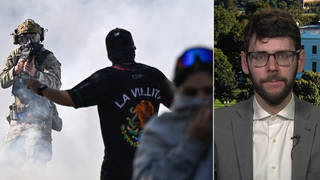
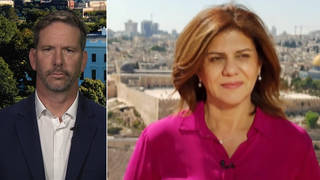
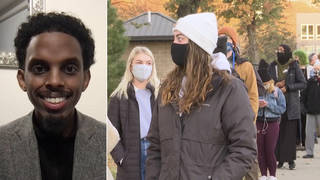
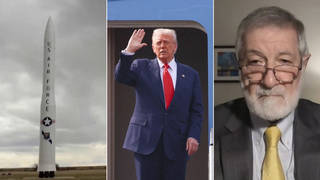





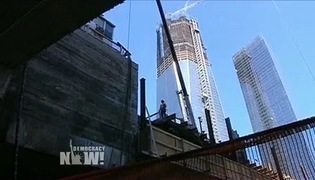
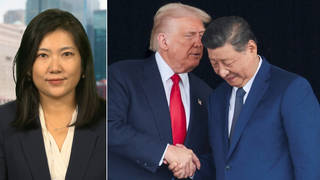
Media Options